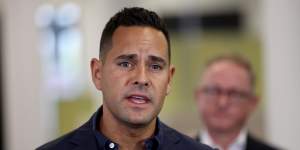NSW crossbench MPs say a tax on unused homes,as has been rolled out in Victoria,could fund further housing for essential workers in addition to putting more properties onto the private rental market.

More than 300 dwellings in the suburbs of Neutral Bay and Kirribilli are considered inactive,according to analysis of electricity usage data for thousands of dwellings by the Australian Bureau of Statistics.
Bondi Beach,Potts Point and Cremorne each have about 200 places where the lights were not turned on for months.
Separate statistics show within the City of Sydney,there are 116,000 residential dwellings and about 23,000 – or one in five – is classified as a “non-primary” residence. Non-primary residences are those used as secondary homes,short-term rentals or that are empty because they are currently being sold. The data is based on 2021 figures compiled using health,education,government payments,income and taxation,employment and population demographics statistics.

Sydney MP Alex Greenwich said many homes,particularly in Millers Point,had been underutilised.Damian Shaw
Chris Minns last year ruled out a tax on second homes,but Sydney MP Alex Greenwich said a levy on vacant homes could be used to fund further housing for essential workers around the inner city.
“I would support some sort of vacancy tax in the inner city,particularly when we look at areas in parts of Millers Point,where former worker housing has been converted into short-term letting,” he said.
He said any tax would address properties that had stood empty for a long time and would discourage land banking,the practice of buying land as an investment,holding it for future use and making no specific plans for its development.
“We don’t want people land banking properties for a future windfall and taking that out of the rental market and the associated impact of that,” he said.
A third of people rent in NSW and Sydney’s median rent for a house reached a 15-year-high of $1063 a week last month,a record also broken by units,which now cost $706 a week,according to SQM Research.

A count of homeless people sleeping on streets and in tents and cars conducted earlier this year found homelessness jumped to 2037,an increase of 26 per cent compared to 2023. In Coffs Harbour,Byron Bay,Newcastle and the Northern Beaches,dozens more people were sleeping rough.
Greens member for Newtown Jenny Leong said it was a sad reflection of the deep inequality while many struggle to afford their weekly rent,others have second or third homes that they are keeping empty during a housing crisis. Many of these homes are used for Airbnb or other short-term holiday rentals.
“Housing should be for people,not a vehicle for making profit. We need policy solutions that shift these empty homes onto the long-term rental market,where they can provide a home for those who desperately need it,” she said.
“These solutions include implementing a levy on homes that are left empty for more than six months,with the funds then used to build more public,social and genuinely affordable homes,and empowering local councils to better regulate the number and location of short-term rentals in their LGAs.
She called for other measures to address housing affordability including controls on rent and an end to unfair no grounds evictions.